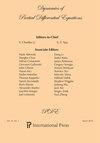具有非线性信号产生和非局部增长项的抛物-椭圆Keller-Segel系统
IF 1.1
3区 数学
Q2 MATHEMATICS, APPLIED
引用次数: 0
摘要
和光滑有界域$\Omega \subset \mathbb{R}^n (n \geq 1)$上齐次Neumann边界条件下的非局部增长项\[\begin{cases}u_t = \Delta u - \chi \nabla \cdot (u^m \nabla v) + u \Biggl( a_0 - a_1 u^\alpha + a_2 \displaystyle \int_\Omega u^\sigma dx \Biggr) & (x, t) \in \Omega \times (0,\infty) \; , \\0=\Delta - v + u^\gamma , & (x, t) \in \Omega \times (0,\infty) \; , \\\end{cases}\],其中$\chi \in \mathbb{R}, m, \gamma \geq 1$和$a_0, a_1, a_2, \alpha \gt 0$。•当$\chi \gt 0$时,如果参数满足某些适当的假设,则上述系统的解是全局一致有界的。•当$\chi \gt 0$时,系统具有一个全局有界的经典解,假设$a_1 \gt a_2 \lvert \Omega \rvert$。这些结果表明,斥力机制在保证解的全局有界性中起着至关重要的作用。此外,通过构造能量泛函,导出了化学吸引或化学排斥系统全局有界解的大时间行为。本文章由计算机程序翻译,如有差异,请以英文原文为准。
On a parabolic-elliptic Keller–Segel system with nonlinear signal production and nonlocal growth term
and nonlocal growth term\[\begin{cases}u_t = \Delta u - \chi \nabla \cdot (u^m \nabla v) + u \Biggl( a_0 - a_1 u^\alpha + a_2 \displaystyle \int_\Omega u^\sigma dx \Biggr) & (x, t) \in \Omega \times (0,\infty) \; , \\0=\Delta - v + u^\gamma , & (x, t) \in \Omega \times (0,\infty) \; , \\\end{cases}\]under homogeneous Neumann boundary conditions in a smoothly bounded domain $\Omega \subset \mathbb{R}^n (n \geq 1)$, where $\chi \in \mathbb{R}, m, \gamma \geq 1$ and $a_0, a_1, a_2, \alpha \gt 0$. • When $\chi \gt 0$, the solution of the above system is global and uniformly bounded, if the parameters satisfy certain suitable assumptions. • When $\chi \gt 0$, the system possesses a globally bounded classical solution, provided that $a_1 \gt a_2 \lvert \Omega \rvert$. These results indicate that the repulsive mechanism plays a crucial role in ensuring the global boundedness of solutions. In addition, the paper derives the large time behavior of globally bounded solutions for the chemo-attractive or chemo-repulsive system by constructing energy functionals.
求助全文
通过发布文献求助,成功后即可免费获取论文全文。
去求助
来源期刊
CiteScore
2.00
自引率
0.00%
发文量
7
审稿时长
>12 weeks
期刊介绍:
Publishes novel results in the areas of partial differential equations and dynamical systems in general, with priority given to dynamical system theory or dynamical aspects of partial differential equations.

 求助内容:
求助内容: 应助结果提醒方式:
应助结果提醒方式:


